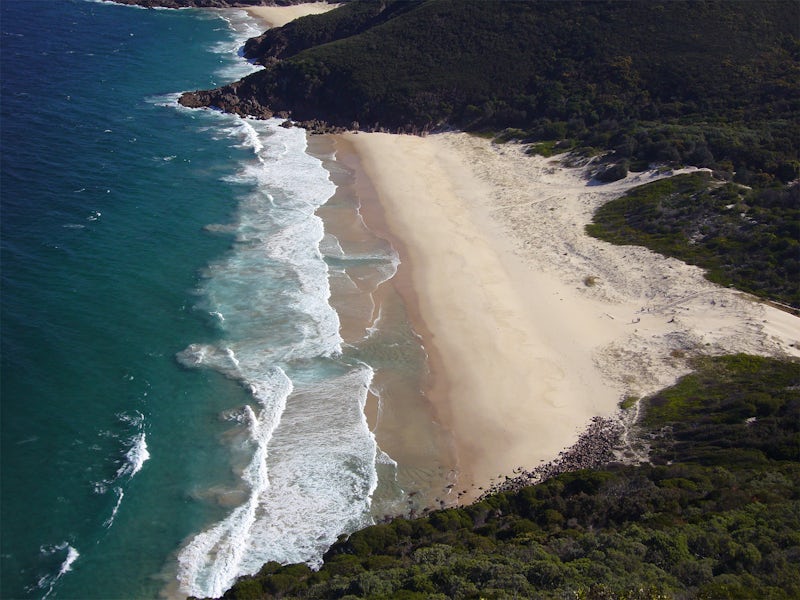Can you spot a rip current?
Take our 5-minute quiz on Australia's number-one coastal hazard
Rip currents are powerful, fast-moving currents that flow away from the shore, often occupying deep channels, and pose a significant hazard to swimmers. They are responsible for an average of 21 drownings a year in Australia, which is more deaths than bushfires, floods, cyclones and sharks combined.
Thousands of people get caught in rip currents each year around Australia. Research has shown rips are more complex than previously thought and there is no single piece of advice for escaping a rip that works for all conditions and people. What you may have been taught to do as a kid may not actually be the best advice.
This quiz will teach you how to spot a rip, what to do if you're caught in one and to remind you to always swim between the red and yellow flags on patrolled beaches. Good luck!
Keep scrolling to move to the next question...


Click to
add a pool
Here is an aerial shot of Zenith Beach, near Port Stephens, NSW.
Can you circle the rips?
Click (or press) & drag to draw,
then keep scrolling to reveal the answer
Here they are! It's important to remember there can be more than one rip at a beach.
Viewing from the sky makes it a lot easier to spot rips, but that's not how we normally see a beach...
This view is a bit more realistic.
Can you circle the rip here?
Rips often begin by flowing along the beach and then out. And they don't always flow in a straight line offshore.
OK, let's increase the difficulty...
Can you spot a rip when you are much closer to the water?
Here it is!
It often helps to look sideways along the beach to spot rips.
OK, let's take your knowledge to the next level.
Here's another shot, at Lighthouse Beach in NSW.
Lifeguards and lifesavers put up a pair of red and yellow flags and people are encouraged to always swim or bathe 'between the flags'.
Drag the flags to where you think
is the best place for people to go in the water.
This beach is unpatrolled and has a lot of rips
and should be treated with extreme caution.
In general, on any beach the safest places to enter the water are where there's lots of whitewater from breaking waves. That's where the flags are normally placed.
But the reality is that if there are no flags, you shouldn't go in the water.
Now let's look at how a rip works...
Here we placed harmless fluorescent yellow dye
into the water to visualise the current.
Drag the circles to where you think
the dye will move from now
to 30 seconds, 1 minute and 2 minutes.
Hit 'play video' or keep scrolling to see what happens.
Rip currents can reach over two metres per second, which is as fast as an Olympic swimmer! 🏊♀️
Rips can also pull you very far out to sea.
In this video we used
purple dye to visualise the rip.
Hit the + symbol to generate an Olympic pool and resize it to guess how many 50m pool-lengths a rip can take you from shore.
This is a big rip. It stretches three Olympic pools into the ocean – would you be able to swim along the beach and back in with the breaking waves?
What about if you actually get caught in a rip? What should you do?
In this scenario you walked or swam into the start of a rip.
Click on what you should do next...
Great work. Now you know how to spot a rip, how they work and what to do if you find yourself in one.
Remember that the best way to avoid a rip and to be safe on a beach is to always swim between the red and yellow flags.
Survive a rip current
To recap, the latest advice is to float and signal for help. The traditional advice about swimming parallel doesn't always work because some rips flow at angles to the beach, so you might be swimming further into one or against the current.
- Stay calm: relax and don't panic.
- Don’t fight the current: don't try and swim back to the beach against the rip current flow.
- Float and signal for help: stay afloat, conserve your energy and signal or call for help to alert lifeguards or nearby surfers.
- Aim for whitewater: if you are a very good swimmer, you can try to swim slowly to the side of the rip by aiming for the whitewater and breaking waves.
Prevention and Awareness
Rip currents occur on any beach that experiences breaking waves across a surf zone. Rips occur in all conditions including beautiful sunny days with small waves. There are also different types of rips that have different visual clues. If you would like to learn more about rip currents, please visit these educational resources:
Of course the best way to avoid getting caught in a rip current is to always swim between the red and yellow flags on beaches patrolled by lifeguards and lifesavers. Safe swimming!